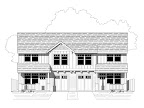The APA (those wood people again) have issued a report on raised heel (AKA energy) trusses. Typical trusses do not allow full height insulation out to the outside edge of an outside wall. This means that the thermal envelope of your house is compromised where the roof comes down to the wall. This would be akin to the back of your neck where your coat doesn't quite reach up to nor does your wool hat reach down to. So consider raised heel trusses to be a scarf for your home.
Builders harumph about several issues. Mainly plywood and siding and the extra cost. How much extra cost, Captain Pennypincher? Yes, it does cost extra. But could you perhaps use all those drops from your sheathing in that extra 8-12" space? But the taller blocking is also a somewhat valid point
The report gives some simplified methods for securing the trusses without complicated blocking. The report is applicable for trusses with a heel between 15-1/4" and 24"; using continuous plywood (CS) as a prescriptive shear bracing method; for homes in seismic zones A, B, and C; for homes with wind exposure of 110mph or less; a whole list of other fairly typical conditions.
In essence, plywood has been found to be adequate to replace blocking between the tall trusses for all but the top chord itself. That is, rather than using stacked 2x12's (illegal anyway) or a truss company built blocking solution, the plywood can extend to the bottom edge of the top chord. Typical 2x4 bird-blocking can be used on top of that.
Thankfully, you as a builder do not have to figure this all out. Talk to your designer about simplified solutions for energy heel trusses. Here at Istockhouseplans, we're always happy to help you get the most bang out of your buck.
See the full report here (an account or login may be required):
http://www.apawood.org/level_c.cfm?content=pub_searchresults&pK=Form%20SR-103&pF=Yes
Tuesday, April 29, 2014
Subscribe to:
Post Comments (Atom)






No comments:
Post a Comment